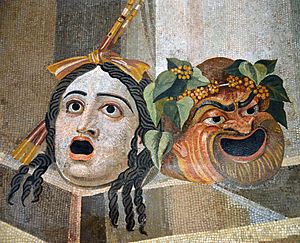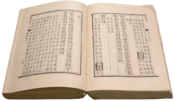Tragicomedy facts for kids

| Literature |
|---|
 |
| Major forms |
| Genres |
| Media |
|
| Techniques |
| History and lists |
|
| Discussion |
|
Tragicomedy is a special kind of story, usually a play, that mixes parts of both sad and funny stories. Imagine a serious play that also has enough jokes or light moments to make you feel better. Or, it could be a serious story that ends happily.
The name "tragicomedy" tells you exactly what it does. It wants you to feel both the deep emotions of a tragedy (which is about human suffering) and the joy and laughter of a comedy.
Contents
What is Tragicomedy?
Tragicomedy is a type of play or story that combines elements from both tragedy and comedy. It aims to make the audience feel a mix of serious emotions and also laugh.
How it Started: Ancient Times
The idea of mixing serious and funny parts in a play isn't new. The Greek thinker Aristotle talked about plays that were serious but had happy endings. For example, the ancient Greek play Alcestis could be seen as a tragicomedy.
The word "tragicomedy" itself was first used by a Roman playwright named Plautus. He made up the word tragicomoedia (Latin for tragicomedy) in a funny way for his play Amphitryon. In the play, a character named Mercury says he will mix things up. He explains that since there are kings and gods (who usually appear in serious tragedies) along with servants (who are often in comedies), the play should be a "tragicomedy."
Tragicomedy Comes Back: The Renaissance
After ancient times, tragicomedy became popular again during the Renaissance, especially in Italy and England.
Italy's Influence
Two important people helped make tragicomedy a proper type of play with its own rules.
- First was Giovanni Battista Giraldi Cinthio. He was a writer in the mid-1500s. He thought that tragic stories with happy endings (which he called tragedia a lieto fine) were better for the stage than sad tragedies.
- Even more important was Giovanni Battista Guarini. His play Il Pastor Fido, published in 1590, caused a big discussion. Guarini defended his new style of play, and his ideas won out. His tragicomedies had balanced action, polite characters, and often took place in peaceful, natural settings. These ideas became very popular in Europe for over a hundred years.
England's Take
In England, playwrights were already mixing serious and funny elements before there were strict rules. In the 1500s, "tragicomedy" often meant a romantic play that didn't follow the usual rules of time, place, or action. These plays mixed characters from high and low social classes and had amazing, fantastical events.
The writer Philip Sidney didn't like these "mungrell Tragy-comedie" plays. Even William Shakespeare's later plays, which are often called "romances," have elements of tragicomedy.
Later, in the early 1600s, English playwrights like John Fletcher started to use the ideas from Italy. Fletcher's play The Faithful Shepherdess (1608) was based on Guarini's work. Fletcher gave a famous definition of tragicomedy: "A tragi-comedie is not so called in respect of mirth and killing, but in respect it wants deaths, which is enough to make it no tragedy, yet brings some neere it, which is inough to make it no comedie." This means a tragicomedy doesn't have deaths, but it gets very close to them, making it not a comedy either. Fletcher's tragicomedies often had surprising twists, unusual plots, faraway settings, and fancy language.
Other English writers like Philip Massinger and James Shirley also wrote popular tragicomedies. This type of play stayed popular until theaters closed in 1642. Even after theaters reopened, Fletcher's works were still enjoyed. Over time, the "tragedy with a happy ending" style developed into what we now call melodrama.
Later Developments
After the Renaissance, people started to think about tragicomedy more in terms of its themes and style, not just the plot. Gotthold Ephraim Lessing said it was a mix of feelings where "seriousness stimulates laughter, and pain pleasure."
In modern theater, especially after World War II, tragicomedy is very common. It's often seen in "dark" comedies or absurdist plays, which explore serious topics in a strange or funny way. Playwrights like Samuel Beckett, Tom Stoppard, and Harold Pinter have written in this style. The Swiss writer Friedrich Dürrenmatt believed tragicomedy was the perfect type of play for the 20th century. He called his play The Visit (1956) a tragicomedy.
Modern Tragicomedy in the United States
In the United States, writers and TV shows have also used tragicomedy, often with gallows humor (dark humor about serious or sad topics). For example, David Foster Wallace's 1996 novel Infinite Jest is a tragicomedy. It finds funny moments in a serious place like a halfway house, which is full of human suffering.
Many modern TV series are also described as tragicomedies. These include Succession, Breaking Bad, Better Call Saul, Fleabag, I May Destroy You, BoJack Horseman, Barry, Made for Love, and The White Lotus. They all blend serious themes with humor.
See also
 In Spanish: Tragicomedia para niños
In Spanish: Tragicomedia para niños
- Comedy drama
- Outrapo
- Shakespearean problem play
- Theatre of the Absurd

